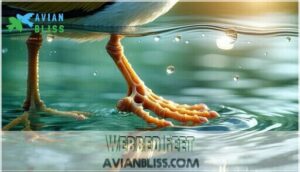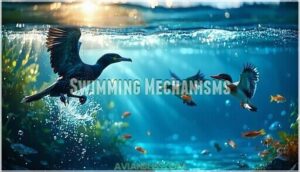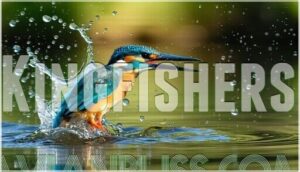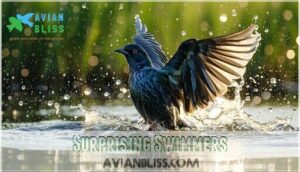This site is supported by our readers. We may earn a commission, at no cost to you, if you purchase through links.

Over 400 bird species have mastered aquatic skills that’ll blow your mind.
Penguins rocket through water at 22 mph using their wings like underwater jets.
Loons dive deep with webbed feet, while kingfishers plunge with sniper precision.
Even common starlings can paddle across ponds when needed.
These feathered swimmers use waterproof feathers, streamlined bodies, and specialized techniques to navigate water like pros.
From wing propulsion to foot paddling, birds have cracked the code of aquatic life.
Nature’s got some serious tricks up her sleeve regarding unexpected swimming champions.
Table Of Contents
Key Takeaways
- Birds like penguins, loons, and ducks are exceptional swimmers with specialized adaptations like waterproof feathers, webbed feet, and streamlined bodies.
- Aquatic birds use different swimming techniques, including wing propulsion, foot paddling, and plunge diving, to thrive in water.
- Some land birds, like starlings and sparrows, can adapt and swim when necessary, though they lack the specialized features of aquatic species.
- Evolution has shaped aquatic birds over millions of years, developing traits like buoyancy control, waterproofing, and efficient diving mechanisms.
Can Birds Swim?
You might wonder if birds can swim beyond just floating on water’s surface.
The answer breaks free from common assumptions – many birds are exceptional swimmers.
While not all species master aquatic environments, swimming birds like penguins, loons, and waterfowl have evolved specialized adaptations.
These aquatic birds use distinct swimming styles, from wing propulsion to foot-powered movement, thriving in diverse swimming bird habitats.
From graceful paddling to torpedo-like dives, swimming birds have mastered water with remarkable evolutionary precision.
These adaptations often include waterproof feathers and streamlined bodies.
Aquatic Bird Adaptations
You’ll notice that swimming birds have special features that help them move through water efficiently.
Their bodies show three main changes: waterproof feathers that keep them dry, webbed feet that work like paddles, and smooth body shapes that cut through water easily.
They have these features to improve their movement through water.
Waterproof Feathers
Aquatic birds possess remarkable waterproof feathers that keep them dry while swimming.
These specialized feathers create nature’s perfect wetsuit through precise engineering:
- Oil Gland secretions coat each feather during preening, creating hydrophobic properties
- Feather Structure features interlocking barbs that form watertight barriers
- Insulation Function traps warm air pockets between feather layers
- Buoyancy benefits help birds float effortlessly on water’s surface
To maintain this, birds often need specialized feather sprays.
Webbed Feet
Webbed feet transform ordinary bird toes into powerful swimming paddles.
You’ll notice different webbing types among aquatic birds – ducks have full webs connecting all toes, while coots sport lobed flaps on each toe.
This webbed foot anatomy boosts swimming efficiency by increasing surface area during propulsion strokes.
Foot size variation matches each species’ needs: pelicans paddle with massive webbed feet, while grebes use smaller lobed versions.
These evolutionary advantages help birds swimming thrive in aquatic environments.
These feet are an amazing adaptation for aquatic life.
Streamlined Body Shape
Water birds showcase remarkable streamlined body shapes that slice through water like living torpedoes.
Their hydrodynamic efficiency comes from evolutionary advantages that maximize underwater maneuverability while minimizing drag reduction challenges.
Key bird physical adaptations include:
- Torpedo-shaped bodies that reduce water resistance
- Compact feathers that maintain ideal body density
- Sleek profiles enhancing bird swimming ability
- Streamlined necks facilitating swift aquatic adaptations
The combination of these adaptations enables water birds to thrive in their environments, making them highly efficient swimmers with evolutionary advantages.
Swimming Mechanisms
You’ll discover that swimming birds use three main methods to move through water: wing propulsion, foot propulsion, and plunge techniques.
Each method works differently, with some birds using their wings like underwater paddles while others rely on their webbed feet to push forward, utilizing complete concepts in their movement.
Wing Propulsion
Looking at wing-propulsion swimmers, you’ll discover how penguins and auks transform their wings into underwater propellers.
These birds achieve remarkable wing speed and energy efficiency through specialized wing shape adaptations.
| Species | Wing Speed | Depth Range | Energy Efficiency |
|---|---|---|---|
| Penguins | 8 mph | 500+ feet | Highest |
| Auks | 6 mph | 200 feet | High |
| Petrels | 4 mph | 50 feet | Moderate |
| Cormorants | 3 mph | 100 feet | Good |
This wing-propulsion method offers evolutionary advantages through superior underwater maneuverability.
The hollow bone structure aids in reducing weight for efficient movement.
Foot Propulsion
Not all swimming birds rely on their wings. Some species master foot power instead. Grebes use lobed feet for efficient paddling, while loons kick with webbed feet for prolonged plunges.
These aquatic birds showcase amazing grebe locomotion and loon swimming techniques. The American dipper even walks underwater using strong foot propulsion through rushing streams. Some species, like those with specialized foot adaptations, are particularly adept at this.
Here are five foot-powered swimming masters:
- Loons thrusting through dark lake waters
- Grebes gliding silently across pond surfaces
- Coots splashing frantically between cattails
- Gallinules tiptoeing over floating lily pads
- American dippers bouncing along rocky streambeds, demonstrating amazing aquatic abilities.
Plunge Diving
How do gannets and boobies turn gravity into their hunting superpower?
These plungediving masters rocket from heights up to 100 feet, reaching incredible dive speed while their streamlined bodies cut through water with tremendous impact force.
Their specialized underwater vision and precise prey capture techniques make this high-energy expenditure method incredibly effective for bird swimming success.
Famous Swimming Birds
You’ll discover that some birds are natural water athletes with amazing swimming skills that might surprise you.
These well-known swimmers use special body features and techniques to move through water just as easily as they fly through air.
Penguins
Emperor penguins can dive 1,800 feet deep, staying underwater for 22 minutes while hunting fish and krill in Antarctica’s icy waters.
These flightless birds use their flipper-like wings to "fly" through water at speeds up to 22 mph.
Their specialized feet aid in swimming, which is a crucial aspect of their survival in the Antarctic habitat.
Seventeen penguin species face conservation challenges from climate change, making their Antarctic habitat increasingly fragile for these remarkable aquatic birds.
Loons
Loons rule northern waters with their torpedo-shaped bodies and powerful webbed feet.
These aquatic birds can dive 200 feet deep, staying underwater for minutes while hunting fish. You’ll spot them gliding across lakes, then vanishing beneath the surface like feathered submarines.
- Loon Habitats: Prefer clear, deep lakes across Canada and northern United States
- Loon Diet: Expert fish hunters that also eat crustaceans and aquatic insects
- Loon Behavior: Famous for their haunting calls that echo across wilderness waters
- Loon Migration: Travel to coastal waters during winter months for warmer temperatures
Gannets
Watch gannets transform into living torpedoes as they execute their signature highspeed dive from 100 feet above ocean waves.
These remarkable seabirds plummet at 60mph, using specialized plumage adaptations like reinforced skulls and streamlined bodies.
Diving birds par excellence, they practice flock hunting strategies across their coastal habitat range, though conservation status concerns mount due to climate change impacts.
Kingfishers
Like living arrows, kingfishers execute high-speed dives from riverside perches, their dagger-like beaks piercing water with surgical precision.
These fish-eating birds don’t swim traditionally but plunge underwater briefly to snatch prey.
Their vibrant kingfisher plumage stays waterproof through specialized oils.
Kingfisher habitats include rivers and streams where kingfisher diets consist mainly of small fish, supporting essential kingfisher conservation efforts protecting these remarkable diving specialists.
Dippers
These remarkable aquatic birds defy expectations with their incredible swimming abilities.
American dipper adaptations allow them to thrive in rushing mountain streams where few songbirds dare venture.
Their specialized dipper behavior includes:
- Diving underwater to hunt insects and small fish in their preferred dippers habitat
- Walking along riverbeds using strong feet to grip slippery rocks
- Building nests behind waterfalls for protection from predators
dipper-content
text/markdown
Dippers Section Content
These remarkable aquatic birds defy expectations with their incredible swimming abilities.
American dipper adaptations allow them to thrive in rushing mountain streams where few songbirds dare venture.
Their specialized dipper behavior includes:
- Diving underwater to hunt insects and small fish in their preferred dippers habitat
- Walking along riverbeds using strong feet to grip slippery rocks
- Building nests behind waterfalls for protection from predators
Evolutionary Origins
You’ll discover that swimming birds didn’t start in the water, but evolved from land-dwelling ancestors over millions of years.
These remarkable adaptations happened through convergent evolution, where different bird families independently developed similar swimming features like webbed feet and waterproof feathers.
Transition From Land to Water
Birds didn’t wake up one day deciding to become swimmers.
Evolutionary pressures pushed some species toward water over millions of years.
Habitat selection played a key role as coastal areas offered abundant food sources.
Dietary changes followed, with birds adapting to catch fish instead of insects.
Behavioral shifts included spending more time near water, while predation risks from land predators made aquatic environments safer refuges for survival.
Adaptations for Diving
Moving from terrestrial life to aquatic environments, birds developed remarkable diving adaptations.
Aquatic birds evolved specialized features that let them thrive underwater:
- Feather Density increases to trap air pockets for buoyancy control
- Oxygen Storage systems in blood and muscles extend dive times
- Pressure Resistance through reinforced bone density and waterproof feathers
These bird adaptations enable successful underwater swimming in marine habitats.
Convergent Evolution
Independent Development creates fascinating patterns when aquatic birds face Similar Niches.
Environmental Pressures shape waterfowl species from different families to develop identical Analogous Structures.
Penguins and auks aren’t closely related, yet both evolved flipper-like wings for water propulsion.
Swimming birds demonstrate how nature finds the same solutions repeatedly, despite Shared Ancestry being absent in their bird adaptations.
Birds’ hollow bone structure aids in flight and buoyancy.
Surprising Swimmers
You’ll be amazed to learn that some common backyard birds can actually swim when they need to survive.
Starlings and house sparrows aren’t built for water, but they can paddle across small ponds using their wings and feet in emergencies.
Starlings
Despite lacking webbed feet, European starlings surprise scientists with their natural swimming abilities.
These common birds paddle through water with grace, using wing motions similar to diving birds. Their unexpected aquatic skills reveal how quickly birds adapt to new environments.
Here’s what makes starling swimming remarkable:
- Puffin-like strokes – They move through water with surprising elegance
- Directional control – Feet guide precise underwater navigation
- Wing coordination – Motions mirror specialized diving birds
- Rapid adaptation – Skills emerge without aquatic breeding
House Sparrows
House sparrows break every rule about which birds can swim.
These tiny urban champions paddle through water using rapid wing beats and coordinated leg kicks.
Their sparrow behavior adapts quickly to new challenges, proving that not all swimming birds need webbed feet.
While most land birds avoid water completely, house sparrows demonstrate remarkable urban adaptation skills that help them survive in diverse environments worldwide.
Other Land Birds
Most land birds face serious drowning risks due to terrestrial adaptations and land bird limitations. Non-aquatic survival means they lack waterproof feather waterproofing.
However, some surprising species break the rules:
- Great Horned Owls can paddle awkwardly when necessary
- European Starlings show natural swimming instincts despite their design
- Gallinules walk on floating vegetation and swim confidently
- Blackbirds use their feet to paddle short distances
- Robins occasionally cross small water bodies using wing-assisted swimming
Buoyancy Adaptations
You’ll discover that birds use three main features to stay afloat: hollow bones that reduce weight, air sacs that act like built-in life jackets, and special feathers that control how much water they absorb.
These adaptations work together to help swimming birds float easily or sink quickly when they need to catch prey underwater, utilizing their air sacs to achieve this.
Hollow Bones
Bird bones aren’t solid like yours. Bone pneumatization creates hollow spaces that reduce bone density while maintaining skeletal strength.
This evolutionary advantage helps birds achieve perfect buoyancy control underwater. Here’s how hollow bones work:
- Flight efficiency – Lighter bones reduce energy costs during swimming
- Buoyancy regulation – Air-filled spaces help control floating depth
- Structural support – Maintains strength despite reduced weight
Air Sacs
Air sacs work like built-in flotation devices for swimming birds.
These specialized respiratory structures help control buoyancy by adjusting air volume inside the body.
When birds need to float, they fill their air sacs with extra air.
For diving, they release air to sink faster.
This avian anatomy gives aquatic birds precise control over their underwater adaptations.
Feather Wettability
Beyond air sacs, feathers themselves control buoyancy through clever wettability tricks.
Different birds manage their feather oil glands and preening behavior to create hydrophobic barriers when needed. You’ll find some species actually adjust their feather structure’s water repellency on purpose.
Here’s how birds master feather wettability:
- Cormorants reduce oil production to let water penetrate their waterproof feathers for easier diving
- Grebes squeeze trapped air from their feather structure to sink below the surface quickly
- Ducks enhance preening behavior before swimming to strengthen their hydrophobic barriers against water
- Anhingas spread wings after diving because their adaptations include partially wettable feathers for better underwater movement
Implications for Bird Evolution
When you study birds that swim, you’re looking at millions of years of evolutionary changes that shaped their bodies for water life.
These swimming abilities show how quickly birds can develop new traits, from webbed feet to waterproof feathers, proving that evolution responds fast to environmental needs.
Rapid Adaptation
Through millions of years, environmental pressures have shaped remarkable aquatic birds with stunning speed.
Genetic mutations triggered behavioral shifts that transformed land species into skilled swimmers.
- Dietary changes drove birds to exploit underwater food sources
- Survival strategies evolved rapidly through natural selection processes
- Bird swimming techniques developed as adaptations to harsh climates
These diving specialists showcase evolution’s incredible flexibility, with stunning speed being a hallmark of their development.
Innate Behaviors
You’ve witnessed something remarkable when you see a duckling’s first paddle stroke.
Instinctual Swimming kicks in immediately, no practice needed.
Prewired Diving behaviors emerge naturally in young birds, suggesting Genetic Predisposition rather than Learned Swimming.
This Duckling Paddling coordination appears hardwired into their DNA.
Evolution programmed these swimming adaptations directly into bird behavior patterns, making water interaction feel completely natural from birth.
Physical Constraints
Physical limits determine which birds master swimming and which don’t.
Bone density affects buoyancy – denser bones help diving birds stay underwater. Wing size and muscle strength control propulsion power.
Heavy body mass creates challenges for surface swimming. Feather density impacts waterproofing effectiveness.
These constraints explain why penguins excel underwater while sparrows struggle, despite having webbed feet adaptations.
Frequently Asked Questions (FAQs)
Can birds swim underwater?
Yes, you’ll find many birds can swim underwater.
Penguins, cormorants, grebes, and diving ducks excel at this.
They’ve got special adaptations like waterproof feathers and streamlined bodies that let them dive deep underwater.
Can birds swim and dive?
Many birds can swim and dive with remarkable skill. You’ll find penguins, cormorants, and loons diving deep for fish, while ducks and grebes surface-dive for food in shallow waters.
What birds can swim?
You’ll find ducks, pelicans, cormorants, and penguins are natural swimmers.
Grebes, loons, and puffins also excel underwater.
These birds have webbed feet, waterproof feathers, and streamlined bodies that make swimming effortless for them.
Are all birds swimming?
Think all birds can take a dip? Not quite!
Only certain birds like ducks, penguins, and cormorants have special adaptations for swimming.
Most land birds lack webbed feet and waterproof feathers needed for aquatic life.
Can birds swim and fly?
Many birds possess dual abilities, excelling at both swimming and flying.
Ducks, pelicans, cormorants, and gannets demonstrate these skills beautifully.
You’ll find they’ve developed balanced adaptations that let them thrive in both aquatic and aerial environments effortlessly.
How do birds swim?
Penguins reach speeds of 22 mph underwater using wing-propulsion.
You’ll see birds swim through different methods: flapping wings like underwater flight, kicking webbed feet, or combining both techniques depending on their body adaptations, which can be seen as a form of underwater flight.
Can regular birds swim?
Most land birds can’t swim because they lack webbed feet and waterproof feathers.
You’ll see them struggle in water since their bodies aren’t built for aquatic life, making drowning a real risk.
What can fly but can’t swim?
Most birds can fly but can’t swim effectively.
You’ll see eagles, hawks, sparrows, and robins soar through skies but avoid water since they lack webbed feet and waterproof feathers needed for swimming.
Why can’t pigeons swim?
Pigeons lack webbed feet and waterproof feathers needed for swimming.
Their body structure isn’t adapted for water – they’d sink and struggle.
You won’t see pigeons floating because they’re built for land and air, not aquatic environments.
Which bird is the best swimmer?
In the context of swimming like a pro, penguins truly take the cake.
Their streamlined bodies and flipper-like wings help them glide through water at impressive speeds, making them the fastest and most efficient swimmers.
Conclusion
Picture a penguin slicing through water like a torpedo—it’s proof that birds can swim and thrive in aquatic environments.
From waterproof feathers to streamlined bodies, these adaptations make their skills remarkable. Whether it’s a loon diving deep or a kingfisher’s precise plunge, birds have mastered water in varied ways.
Even unexpected swimmers like starlings surprise us with their adaptability. Nature’s ingenuity shows us how birds flourish in habitats we wouldn’t expect.
Can birds swim? Definitely, yes!
- https://www.quora.com/Can-birds-swim
- https://www.birdwatchingdaily.com/birds/listicles/15-birds-that-can-swim-and-fly/
- https://web.stanford.edu/group/stanfordbirds/text/essays/Swimming.html
- https://www.science.org/content/article/watch-nonswimming-bird-swim-champ-giving-clues-evolution-penguins
- https://www.nationalgeographic.org/article/ends-earth/
















